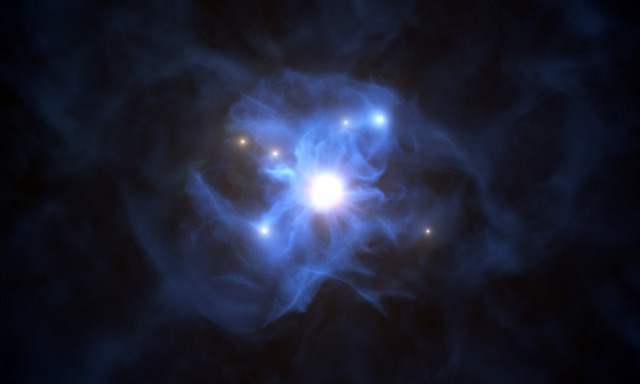
An article published in the journal “Astronomy & Astrophysics Letters” reports a study on a group of six galaxies surrounding a supermassive black hole which date back to an early epoch when the universe was less than a billion years old. A team of researchers led by Marco Mignoli of the Italian National Institute of Astrophysics (INAF), Bologna, used ESO’s Very Large Telescope (VLT) and the Large Binocular Telescope (LBT) to observe that structure which turned out to be complex as it includes filaments of matter that extend for a distance over 300 times the size of the Milky Way. The gas that concentrates in that structure forms what have been likened to the threads of a spider’s web, and that gas could be responsible for the development of a supermassive black hole in such a remote time.
Understanding the mechanisms that lead to the formation of a supermassive black hole that can have a mass even billions of times the Sun’s is a very important research topic in the field of astronomy in recent years. That’s because it’s closely linked to the study of the evolution of galaxies and star formation. The discovery of supermassive black holes in the early universe is a problem because their growth was extremely fast in astronomical terms. Observing objects several billion light years away in the necessary detail is far from easy.
An explanation for the existence of supermassive black holes in the early universe can come from large-scale cosmic structures such as groups of galaxies or protogalaxies with a large amount of gas that can quickly be devoured by a black hole to the point of reaching a mass of millions if not billions of times the Sun’s. Marco Mignoli’s team looked for the right candidate for follow-up observations and chose the quasar cataloged as SDSS J1030+0524, or simply J1030, which is powered by a supermassive black hole and is surrounded by a group of six galaxies. We see that structure as it was about 900 million years after the Big Bang, when the universe was very young.
The researchers used several multi-object spectrographs (MOS) and the DEep Imaging Multi-Object Spectrograph (DEIMOS) instruments mounted on the 10-meter Keck II telescope, MUSE (Multi Unit Spectroscopic Explorer) and FORS 2 (FOcal Reducer and low dispersion Spectrograph) instruments mounted on the VLT, and the Multi-Object Dual Spectrograph (MODS) instrument mounted on the LBT to observe J1030 discovering a cosmic structure composed of filaments of matter that extend for a distance over 300 times the size of the Milky Way. Marco Mignoli compared the gas clusters present in that structure to the threads of a gigantic spider web and stated that galaxies are found and evolve where these filaments cross. Large amounts of gas flow through them, feeding both the galaxies themselves and probably the supermassive black hole at the center of this structure.
This discovery in some ways shifts the problem, in the sense that if galaxies and supermassive black hole were formed thanks to that structure, what formed that structure? According to the astronomers, the key is in the giant halos of dark matter. They may have attracted huge amounts of gas in an even more remote era, and their combination could be the cause of those cosmic webs.
According to Roberto Decarli, another astronomer from INAF, Bologna, who participated in this study, the team’s discovery supports the idea that more distant and massive black holes form and grow within massive dark matter halos within large-scale structures, and that the lack of previous sightings of such structures was probably due to observational limitations. In fact, it took the combination of several instruments mounted on three of the largest telescopes in the world to discover the cosmic web around J030.
The instruments used confirmed the presence of six galaxies around quasar J030, but there were also other candidates. The problem is that they’re so far away that it’s difficult to obtain observations good enough to establish their position and therefore the distance from the quasar with the necessary precision. Also for this reason, the studies will continue.
Barbara Balmaverde of INAF, Turin, also part of the team that conducted this study, mentioned ESO’s Extremely Large Telescope, under construction in Chile, as an instrument for future observations. In the coming years we can expect new discoveries on supermassive black holes, especially primordial ones, and on the influence they have on the galaxies that host them.

